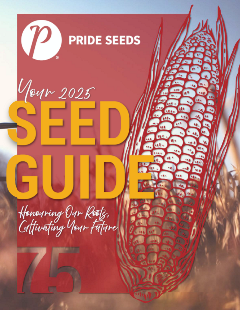WELCOME JEREMY O'SHEA TO PRIDE SEEDS

Enhance your knowledge and stay ahead with PRIDE SEEDS Corn and Soybean School videos.
Browse our selection of products below
___________________________________________________________________________________________________________________________________________

2024-2025 PRIDE Seeds Product GuideYou can find all of our products on the website, including supporting performance data and create your own personalized guide called My Guide. You can also download the digital version of our printed product guide which includes product comparison charts. |
SHOP THE PRIDE SEEDS E-STORE
-7.png?sfvrsn=87920db3_3)
STAY UP-TO-DATE WITH PRIDE SEEDS LATEST BLOGS, NEWS AND ARTICLES
Corn School: Building a gibberella defence
A wet growing season plus high humidity and moisture at tasseling has many Ontario corn producers asking about the potential for ear mould and gibberella when combines start to roll at harvest.
On this episode of the RealAgriculture Corn School, host Bernard Tobin is joined by PRIDE Seeds product manager Matt Chapple for a look at what seed companies can do to test for ear rot susceptibility to ensure hybrids have a strong defence against ear mould.
In the video, Chapple demonstrates how experimental hybrids are inoculated with disease pathogens to test their ability to fight off ear rot infections that can produce DON in grain.
In the disease trials, Chapple says researchers look for several factors, including husk coverage and grain drydown characteristics, to distinguish more susceptible hybrids from those that provide stronger protection.
“A hybrid that’s more likely to hold its ear upright later in the season, through grain fill and into black layer stages, is obviously more at risk if tough environmental conditions exist,” says Chapple “Hybrids that tend to maybe droop the ear a little bit more horizontally into the row, and flare open the husk later in the season, tend to have a little less susceptibility.” (Story continues after the video.)
Hybrids that are more susceptible tend to have higher incidence of infection across the ear and can lead to very high levels of DON at harvest. Chapple says testing goals include identifying experimental hybrids in research plots that have poor defence against ear rots and removing them from the product development pipeline.
For farmers who are fearful of gibberella as harvest nears, Chapple says it’s important to keep “eyes on ears.” He recommends growers keep a close watch on high-risk fields, especially those that are uneven, have tight husks or stands with higher percentages of late-emerging plants.
“If we have a concern, we’re going to want to get after it. We want to get that [corn] out of the field sooner than later. We want to get it dried and conditioned and minimize the risk of those DON levels rapidly increasing from further adverse weather conditions later in the growing season.”
Tap here for more Corn School videos.
TAKE PRIDE IN YOUR INBOX
Expert advice, news and information
THE PRIDE SEEDS ADVANTAGE
Farming is one of the most demanding industries in the world, subject to a variety of factors such as time, weather, and global pressures. You know this every time you look out the window and think about the field in front of you. Growers and dealers deserve an advantage: The PRIDE Seed Advantage.
LEARN MORETHE PRIDE SEEDS ADVANTAGE
Every year PRIDE Seeds works hard to produce leading-edge products that enable success where it matters most, on your farm. Our dedicated team strives to provide sales expertise, agronomy support, quality production, and service tailored to meet your needs.
LEARN MORE

Leave a commentOrder by
Newest on top Oldest on top